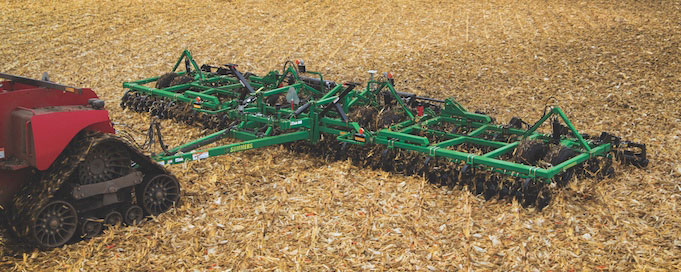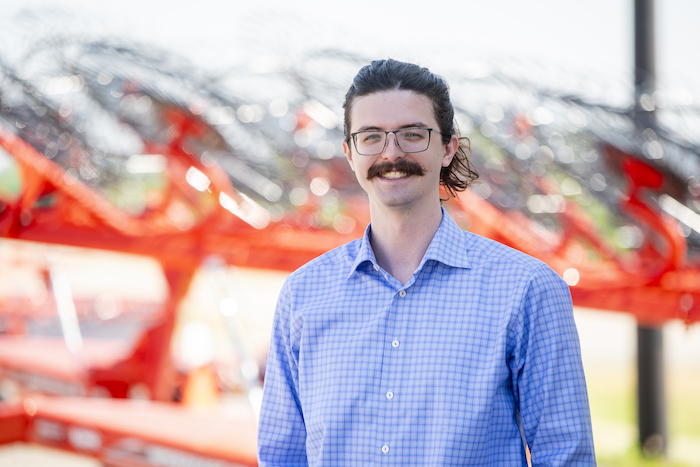Regardless of tillage practices, no growers were safe from last year’s weather. With the summer’s moisture sticking around into the fall (and in some places into the winter), many growers missed crucial fall tillage to get their seedbeds ready. Now no-tillers, facing combine ruts, unprepped seedbeds, residue and weed control issues, are looking to dealers and manufacturers for what options they have to till their problems away.
A survey from No-Till Farmer, a sister publication of Farm Equipment, reported that roughly 66% of no-till growers raising corn got 50% or more of their acres planted in 2019, while 23% got less than half planted; 69% of respondents who raise soybeans planted at least half of their acres and 18% planted less than half. Additionally, 61% of farmers believed their no-till system helped reduce or prevent any negative effects from 2019’s planting challenges when compared to farmers in their area who use tillage. But 29% were unsure if no-till made a difference, and 10% said no-till did not help them. (You can read the full results in the April 2020 issue of No-Till Farmer Conservation Tillage Guide.)
Bruce Johnson, director of strategic innovations at Summers Manufacturing, says that this year’s conditions could create a situation where no-tillers don’t have a choice about whether or not they open the ground. “Something we’ll hear with no-tillers is, if they have a heavy residue matte and a wet spring, they may not be able to put the crop in if they don’t do something to open it up,” he says. “They will use our SuperCoulter to open the field, cut the residue and fracture the soil to let it start breathing and drying out to get their crop in. Vertical tillage is giving them a way to get the crop in when they otherwise may not.”

The Summers Manufacturing SuperCoulter is a good way for no-tillers to crack their residue this spring. Photo courtesy of Summers Manufacturing
The options dealers should keep available to no-tillers vary depending on the type of work they need done. Curt Davis, marketing director at Kuhn Krause, mentioned 3 different products he works with that no-tillers might find useful this spring, depending on how much soil they want to move.
“Products like the Excelerator can be set at a very shallow angle that will only cut the residue and do very little soil disturbance,” he says. “We also have machines like the Inline ripper. We have a no-till shank that allows a customer to operate in the 8-12 inch range and open up any compaction from a wet harvest. It is designed to leave the surface and residue undisturbed. We’ve even seen some growers migrate to strip-till, still having a lot of benefits from leaving two thirds of the field’s residue undisturbed.”

When set at a shallow gang angle, the Kuhn Krause Excelerator succeeds at cutting residue with minimum soil disturbance. Photo courtesy of Kuhn Krause
Sales Manager at Mcfarlane Norm Burgeson pitched harrows as a tool for dealers to recommend to no-tillers to look to this spring but mentions vertical tillage is also prevalent. “For no-tillers, it depends on what they want to accomplish,” he says. “For seedbed prep, nothing works better than a harrow. I’ve attended some no-till conferences in the past where they ask people to raise their hand if you use vertical tillage, more than half the hands in the room go up.”
“The no-till guys that are looking at tillage are the ones with crops sitting flat in the field and know they have to do something …” – Erron Leafloor, Versatile.
Western Canada is seeing no-tillers look to purchase when it comes to getting ready in the spring. Erron Leafloor, tillage product manager at Versatile, mentions that easy access to high-speed tool is one reason Canadian no-till growers are looking at them.
“As you go farther west into the zero till country, there’s a bit more concern,” he says. “The no-till guys that are looking at tillage are the ones with crops sitting flat in the field and know they have to do something. And the easiest tool to get their hands on in Western Canada right now is a high-speed disc. A lot of dealers’ lots have one waiting for them, so that’s usually what they gravitate to. They’re not planning to go into every acre every year, it’s more of a disaster management tool.”






